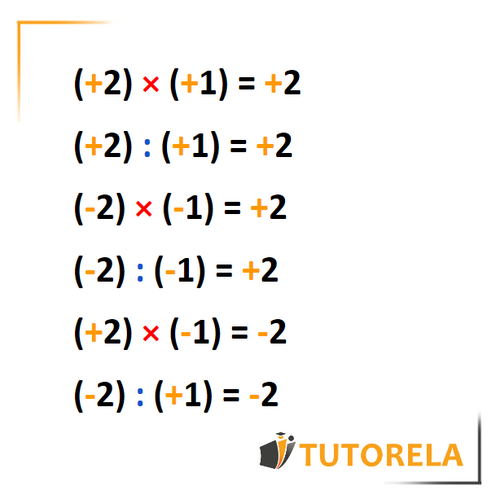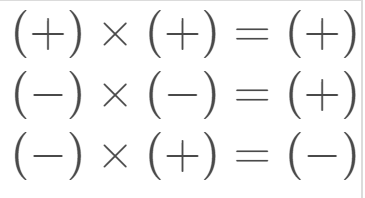Let's see, before multiplying we prefer to simplify the exercise, we will do it in the way we have learned in the addition and subtraction of real numbers, grouping the signs:
- When we have two equal signs they are grouped into one positive.
For example:
(+5)×(+5) or (−5)×(−5)
will become +25
- When we have two different signs they are grouped into one negative.
For example:
(+5)×(−5) or (−5)×(+5)
will become −25
For example:
(+10)×(−5)×(−3)×(−6)×(+8)=
(−50)×(−3)×(−6)×(+8)=
(+150)×(−6)×(+8)=
(−900)×(+8)=−7200
- When we have two equal signs, they are combined into one positive sign.
For example:
(−5):(−5)=+1 / (−5)(−5)=+1
(+5):(+5)=+1 / (+5)(+5)=+1
- When we have two different signs, they are combined into one negative sign.
For example:
(−5):(+5)=−1 / (+5)(−5)=−1
(+5):(−5)=−1 / (−5)(+5)=−1
For example:
(+100):(−2):(−2):(−5):(−2.5)=
(−50):(−2):(−5):(−2.5)=
(+25):(−5):(−2.5)=
(−5):(−2.5)=+2
What are the rules for multiplying and dividing integers?
When talking about integers, we can observe that we will deal with positive and negative numbers, therefore, to be able to perform certain mathematical operations such as multiplication and division, certain rules must be followed which are known as the law of signs or sign rules, which will be described below:
For multiplication, there are two cases
Same signs, that is when multiplying numbers with the same sign
- If we multiply two positive numbers the result will be positive.
- If we multiply two negative numbers the result will be positive.
Different sign
- If we multiply a positive number and a negative one, the result will be negative.
- If we multiply a negative number and a positive one, the result will be negative.
We can summarize this in the following way:
(+)×(+)=+
(−)×(−)=+
(+)×(−)=−
(−)×(+)=−
In the same way for division, the same rule is followed,
Same sign, that is when dividing numbers with the same sign:
- If we divide two positive numbers the result will be positive.
- If we divide two negative numbers the result will be positive.
Different sign
- If we divide a positive number by a negative one, the result will be negative.
- If we divide a negative number by a positive one, the result will be negative.
Summarizing these four statements, we can visualize it in the following way:
(+):(+)=+
(−):(−)=+
(+):(−)=−
(−):(+)=−
How is multiplication of real numbers performed?
As we well know one of the arithmetic operations with real numbers besides addition and subtraction, is the multiplication of real numbers in this case to be able to perform this type of mathematical operations, we must take into account two things, the first is to remember the multiplication tables studied in elementary school and the second is to use the sign laws mentioned before, since when working with real numbers we will find positive and negative numbers.
Example 1.
Task. Perform the following multiplication (6)×(−3)=
Solution:
We can observe that the 6 is a positive number and the −3 is negative therefore (+)×(−)=−
Then the result will be negative, and we just use the multiplication tables, therefore
(6)×(−3)=−18
Result
−18
Example 2.
Task. Perform the following multiplication (−5)×(−7)=
Solution:
We can observe that the −5 is a negative number and the −7 is also negative therefore (−)×(−)=+
Then the result will be positive, and we just use the multiplication tables, therefore
(−5)×(−7)=35
Result
35
How is division in real numbers done?
We have seen that for the division of real numbers the same sign law is followed, so to be able to do the division of real numbers it is enough to make the quotient of said numbers and respect the corresponding sign law, let's see some examples:
Example 1.
Task. Perform the following division (14):(−7)=
Solution:
We can observe that the 14 is a positive number and the −7 is negative therefore (+):(−)=−
Then the result will be negative, and we just do the division
(14):(−7)=−2
Result
−2
Example 2.
Task. Perform the following division (−100):(25)=
Solution:
We can observe that the −100 is a negative number and the 25 is positive therefore (−):(+)=−
Then the result will be negative, and we just make the quotient, therefore
(−100):(25)=−4
Result
−4











